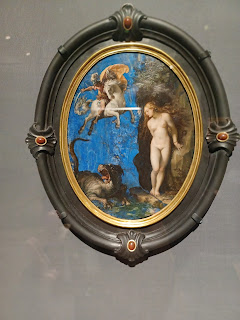Pictures on Stone is currently an exhibit at the St.Louis Art Museum. I must admit that I had no clue as to what I would be viewing, possibly just rocks with pictures on them. Surely it is not possible to paint a picture on a rock and then frame it? Maybe I should give the correct title of this exhibit: "Paintings on Stone:Science and the Sacred 1530-1800". As I viewed the paintings displayed, it was possible to see the science involved in selecting a rock to paint on, and slicing it down so thin that it could be framed. This type of art started in the 12th through 15th century, and took off in the 16th century by Venetian painter Sebastaino del Piombo (1485-1547) who came to Rome in 1511 and encountered competition from the painters Raphael and Michelangelo. There were also arguments between Leonardo de Vinci and Michelangelo about whether sculptures or paintings were the superior art form. So Piombo chose to perfect the art of stone painting, and inspired others to do the same.
In the exhibit there are 70 examples of stone paintings by 58 artists, featuring 34 different stones. The picture above was done with oil on slate by Giorgio Vasari (1511-1574). Many of the pictures are of a religious nature, a few were mythological or portraits of people. In the interpretive signs of some of the Biblical paintings it is noted that the stone support of the picture aids in the religious theme- that of Jesus's role as the cornerstone of the foundation of the church.
Jesus Teaching Mary and Martha
That painting was an oil on agate, artist was Sigismundo Leyrer (1552-1639). The note on this pointed out that the painter did not need to paint the grave site as the painting had the stone support in the picture.Resurrection of Christ
 |
| Portrait of Young Ferdinando Medici |
 | ||
| Perseus Rescuing Andromeda |
The above painting, by Wilhelm Ehrenberg, was done in marble and alabaster. Marble was the most luxurious stone to be used for paintings and it was used sparingly in Northern Europe by artists.
The Nativity was done by the Spanish artist Bartolome Murillo (1617-82). The reflectivity of obsidian lends a deeper spirituality meaning to the painting, as noted by the art museum. Aztecs considered the stone sacred; their empire had been conquered by Spain, through colonization of the Americas.
I hope that I have given you an appetite to see this exhibit, and even if you do not live in St.Louis, it would be worth a few miles or more down the road. Congratulations to the St. Louis Art Museum for a job well done!



No comments:
Post a Comment